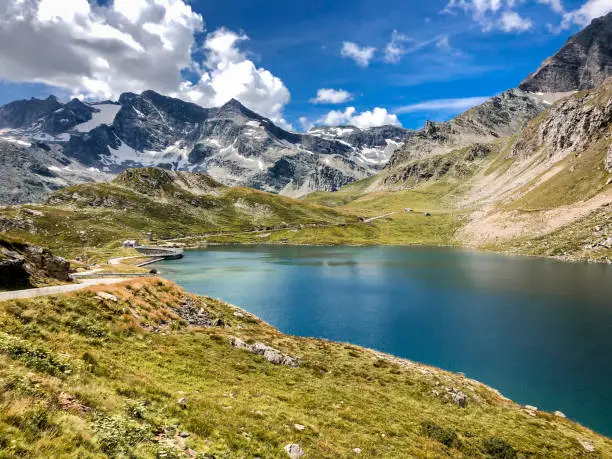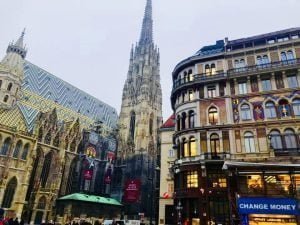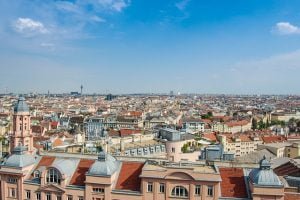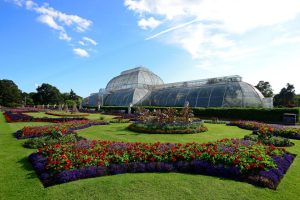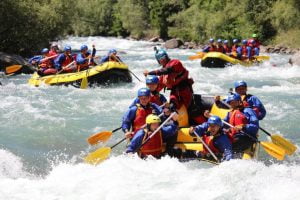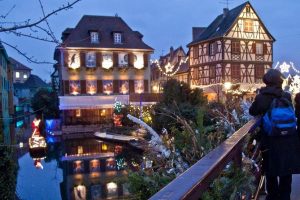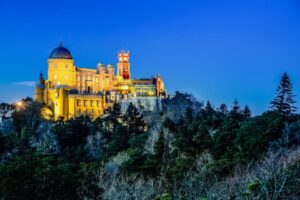The summit point in the Austrian Alps
The Austrian Alps, a breathtaking range of natural splendor stretching across the heart of Europe, sculpting the soul of Austria with its majestic peaks and verdant valleys. This mountain range is not only a geographical wonder, but a symphony of Earth's forces, etched over the ages, giving way to such a wide variety of experiences.
Imagine the first light of dawn caressing the snowy peaks, turning them from deep blue to glowing gold, while the valleys below remain shrouded in mysterious shadows.
As the day progresses, adventurers don skis or snowboards to make their way down pristine white mountain slopes, their exhilarating descent accompanied by the fresh alpine air and the distant echo of cowbells.
Meanwhile, hikers and climbers venture out on unspoiled trails, winding through evergreen forests, passing hidden lakes and challenging their limits against towering rock cliffs.
And yet, amidst all the excitement, the Alps also offer peace - tiny villages, nestled in the mountains, with huts bearing sloping roofs and smoke curling from chimneys, become havens for those seeking respite from the modern world.
Here, time seems to slow down, allowing moments of reflection against the backdrop of huge peaks that touch the sky, in any season, whether under a blanket of snow, a burst of wildflowers or the golden hue of autumn, the Austrian Alps beckon, promising adventure and tranquility, reminding us of the timeless beauty of our planet
A little about Mount Schniberg...
In the Eastern Alps, the Austrian landscape boasts countless breathtaking peaks, alpine meadows and deep valleys.
Among these, Schniberg, the highest mountain in Lower Austria, stands out both for its scenic beauty and its historical significance.
Translating to 'Snow Mountain' in English, Schniberg's majestic height of 2,076 meters provides a panoramic view of the surrounding landscapes, making it a popular destination for hikers and nature lovers.
Located about 80 kilometers south of Vienna, Schniberg is very easily accessible, making it a popular destination for both locals and tourists seeking views and peaks.
The Schniberg mountain, the most eastern and northernmost in the Alps, is a natural barrier, which affects the local climate and geography, in addition, it separates the humid and Atlantic climate of northwestern Europe from the dry and continental climate of the Pannonian plain to its east.
Schniberg has always had a significant location that shaped destinies throughout history, its proximity to Vienna made it a strategic location, and its resources, mainly in the form of ice, were transferred to Vienna for centuries.
In the realm of spirituality, Schniberg has been a destination for many pilgrims - the Klosterwaffen, the highest point of the mountain, is home to a cross that has become a symbol of the summit and a destination for many seeking solace and self-reflection.
Today, Schniberg remains a major attraction for adventurous nature lovers, the Schniberg Railway, a cog railway that opened in 1897, eased access to the mountain, and carried passengers to an altitude of 1,800 meters.
From there, many hiking trails lead to the summit, these routes hardly change, which ensures that both beginners and experienced hikers can find a route that suits them.
Moreover, the mountain is not only a destination for unforgettable summer trips, in winter, it becomes a wonderland offering snow sports such as skiing and snowboarding.
Its slopes are less crowded than some of the more commercialized alpine resorts, making it a favorite for those looking for a more peaceful winter experience.
Mount Schniberg, together with Mount Rex which is located near it, are both referred to by many locals who live in the area, the "Viennese Alps" due to their proximity to the city of Vienna, on a clear day you can see its snowy peak from several observation points around Vienna and even from neighboring Bratislava - the capital of Slovakia.
This mountainous area is rich in fresh water reserves and since 1873 there is a 120 kilometer long water line that flows drinking water to Vienna, this water is considered by many to be the best drinking water in the world!
The mountain is located near the pleasant village of Puchberg (Puchberg am Schneeberg) and from there you can go to the top by an experience train. In the village there are many places to stay and a pampering spa hotel that attracts many visitors from the region and abroad.
The weather at the summit of Mount Schniberg
The prevailing weather around Mount Schniberg and its summit is cool - frozen during most of the year, when
In the months of winter and spring, the top of the mountain is almost completely covered with heavy snow, sometimes you can even see more remnants of snow in the months of May and June.
On the other hand, in the summer months of June and August, the temperatures hover around 20 degrees on bright sunny days and towards the evening the temperatures even drop below 10 degrees.
The months from May to September are considered the rainiest months in this region with an average of 10 rainy days per month.
When you reach the top of the mountain, note that the wind gust may be extremely strong and cold, and the weather may change very quickly, so you should be prepared for quite extreme changes in the weather.
For open-minded travelers who plan to reach the top of the mountain, it is recommended to equip yourself with many layers, from the thinnest to the thickest, and take a thin layer with warmer clothing on top (preferably against wind and rain).
Before arriving, you can check the condition of the lungs and the weather conditions on the mountain through the many cameras installed on it.
These cameras regularly broadcast the updated weather prevailing at the top of the mountain, in addition, you can ask your accommodation in the city about going on different routes, they will be able to tell you where it is recommended to go according to the updated weather.
How to get to the top of Mount Schniberg
If you are considering a trip to this alpine gem, there are several ways to get there depending on your preferences and means of transportation.
Arrival by train -
There are two types of trains coming from the town of Puchberg am Schniberg towards the mountain peak,
The first - the Schniberg cog railway, known as the Schnibergbahn, is one of the most panoramic, fastest and traditional ways to reach the mountain.
The main train station located in the town next to Mount Schneeberg, Puchberg am Schneeberg, has been operating for over a century and takes passengers up to a height of 1,800 meters on the way to the top of the mountain, from there, a short trip will take you to the highest point of the mountain.
The journey offers picturesque views of the landscapes below and is especially popular with families and those looking for a relaxing ride.
The operating times of this train are:
End of July (31.7) to beginning of September (1.9). Sundays and holidays only.
The departure times from the departure station and the return station vary and can be easily checked on the train's official website.
The train ride, both going and returning, takes about an hour and a half, when the cost of the tickets is:
Family ticket (2 parents + 2 children): 104 euros
Adult: 38 euros
Child (6-15): 19 euros
Child up to the age of 6: free (must sit on the parent and not in a separate chair)
Address: Bahnhofplatz 1, Puchberg am Schneeberg
the second train,
The modern Salamander train is the most convenient and fastest way to get near the Schniberg peak.
The train departs from the station in the village of Fochberg and arrives within about 40 minutes of driving to the top station of the mountain (Hochschneeberg) at an altitude of 1800 meters, from there a short walking route will take you to the peak of the Schneeberg mountain.
Operating times of the salamander train (which goes up to the Schniberg peak), from the end of April (27.4/27.10) to the end of October (18/XNUMX), the cost of the trip is XNUMX euros per person.
Our little recommendation - You can stop at the intermediate station (called Baumgartner) and buy one of the famous foods of the mountain at the local bakery, this pastry is called Schneeberg buchteln and it is made of sweet dough filled with rich and sweet jam as well.
In a private car - From Vienna you can reach the base of Mount Schniberg in only about an hour.
The most common route is via the A2 motorway and the S6 motorway, exiting Neunkirchen.
From there follow the signs to Puchberg am Schneeberg, the small town at the foot of the Schneeberg mountain.
There are parking areas available in the town, especially around the valley station of the Schneebergbahn.
For those who prefer a more adventurous ride, there are alpine roads that lead to various trailheads around the mountain, offering a variety of starting points for hikes.
hikers - For those who like to hike, there are several trails that lead to the top of Mount Schniberg. The most popular starting points are via the towns of Lussenheim and Fuchsberg am Schniberg.
These routes vary in difficulty and length, with some suitable for experienced and seasoned travelers and some for regular travelers.
The Fadensteig and the Herminensteig are among the famous routes leading to the summit, offering breathtaking panoramic views along the way.
Arrival on a bicycle route - Mountain bikers can also find their way to Schniberg via a number of mountain bike trails, although not all trails are open to cyclists, some of the trails have been specially designed to cater for this challenging sport.
Always be sure to check the designated routes and respect the natural environment.
Please note, this option is suitable for professional riders and the mountain bike trail is not accessible to everyone, the journey requires high fitness and high navigation and riding skills as well.
For those arriving from the capital city of Austria - Vienna
You can reach the Mount Schniberg area relatively easily from the capital city, Vienna, when the train journey takes about an hour and a half.
First you have to take the high-speed train that goes towards the city of Graz from the central train station of Vienna (Wien HBF).
After half an hour's drive, get off at the Wiener Neustadt HBF station and then change to the regional train (R) that goes towards Puchberg am Schneeberg - the small town located at the foot of the Schneeberg mountain, and get off at this station (this is the last stop of the train).
There you will have to go to the platform from which the salamander train/the ancient cog train departs that reaches the top of the mountain (note: the train to the top of the mountain only operates from the end of April. It is possible to do a walking route to the top, but in winter it is not recommended).
When you arrive at the top station of Mount Shinberg, the panoramic paradise will be revealed to you.
In this place, you can follow the marked path around the edge of the mountain and enjoy wonderful views of the entire area, on days when the visibility is good enough you can even see parts of the neighboring countries to Austria-Hungary, Slovakia, the Herks mountains in the area, the Vienna area and even as far as the Styria area, which is on the border of Slovenia .
The panoramic walking route takes about an hour and a half and is considered easy, so it is also suitable for a trip with small children and families, along the route there are many places to sit where you can relax and enjoy the views and the clear air.
In addition to the walking route, at the upper train station there is a unique art gallery called TOP ART 1800.
This is the highest art gallery in Austria. The works of art are in a modern style called - "spontaneous realism".
A recommendation from us - at the train station you can take an audio guide in English that will give you more information about the regional history, vegetation and landscapes.
Route from the summit back to the town at the foot of the mountain
If you want to continue enjoying the view and the great nature after spending time at the top, you can go back down the marked route down the mountain.
The route is called Zahnradbahnwanderweg and it runs right next to the railway track all the way, back to the small town of Puchberg am Schniberg.
The length of the route is about 10 kilometers and the duration of the route is between 3-4 hours depending on your pace and breaks,
The difficulty level of the route is medium.
The return walking route can be done between the months of April and October, when it starts at the top of the mountain and ends at its foot in an amazing picturesque town.
A little about the town - Fuchberg am Schniberg
In the heart of Austria, nestled among the pristine landscapes of the European Alps, lies the small and mysterious town of Puchberg am Schniberg.
A place where emerald fields merge with alpine peaks, and where history and nature converse in harmony, if you have never heard of it, you are in for a wonderful journey.
On the skyline of the town of Puchberg am Schniberg is the majestic Schniberg mountain, which stands at a height of 2,076 meters at its summit.
Known as the "Monarch of the Eastern Alps", Schniberg serves as a playground for both novice and experienced hikers.
The diverse network of trails, with varying degrees of difficulty, invites everyone to experience the breathtaking views, lush forests and gushing waterfalls.
Upon reaching the summit, visitors are treated to panoramic views that stretch across the plains of Lower Austria and deep into the heart of Europe.
But Puchberg is not only about the spectacular nature that surrounds it, in fact it is a city steeped in history!
The architecture tells stories of bygone eras - from rural farmhouses that have stood the test of time to magnificent buildings reminiscent of Austro-Hungarian opulence.
The local church, with its towering steeple, serves as both a spiritual temple and a testament to the town's rich heritage.
Culture lovers will appreciate the traditional events that dot the calendar all year round. From festivals of local folk music echoing with hushed tones of yodels and alphorns, to winter celebrations that light up the snowy streets with lanterns and laughter, there is always something going on in Puchberg.
The crisp mountain air is a natural elixir, perfect for those looking for a break from the hustle and bustle of urban life. Local spas offer traditional treatments harnessing the healing powers of the alpine environment.
When winter covers the city, it becomes a wonderland for snow sports, skiing, snowboarding, or simply enjoying a hot mug of local chocolate while you watch the snowflakes dance - it's definitely a magical experience.
No visit to Puchberg would be complete without indulging in its culinary offerings.
Austrian cuisine, known for its hearty flavors and delightful pastries, gets a unique twist in this region, local restaurants serve dishes made with fresh produce, and of course, a meal is incomplete without a real Viennese schnitzel or a dish of apple strudel.
Puchberg am Schniberg is more than just a town, it is an experience in itself and beckons travelers with its mesmerizing views, rich history and warm hospitality, it is a place where you can stand on top of a mountain, feel the pulse of centuries-old traditions, and lose yourself in the beauty of the moment, So if you're craving an authentic Austrian experience, make your way to this hidden gem.
In conclusion,
Schniberg, with its impressive stature, rich biodiversity and historical significance, is undoubtedly one of Austria's natural jewels.
A beacon for explorers and a symbol of natural beauty, it serves as a reminder of the timeless magic of the Austrian Alps.
Whether you're looking for adventure, tranquility or simply a connection with nature, Schniberg delivers on all fronts, making it a must-visit for anyone traveling to Austria.
Schneeberg is a mountain in the Austrian Alps, located in the state of Lower Austria. The mountain is the highest peak of the southeastern Alps, and it rises to a height of 2,076 meters above sea level.
Schniberg is a popular destination for hiking, skiing, and cycling. The mountain offers a spectacular view of the Alps and the Vienna Valley.
The history of Schniberg
Schniberg was already known in ancient times, and is mentioned in several historical sources. In the 19th century, the mountain became a popular hiking destination, and is accessible via several trails.
Climbing Schniberg
The easiest way to climb Schniberg is by cable car, located in the village of Neustadt. The cable car goes up to the Karlstätt station, located at an altitude of 1,787 meters. From there, you can continue on foot to the top of the mountain, on a route of about 2.5 kilometers.
You can also climb Shniberg on foot, from several different routes. The most famous route is the red route, which starts in the village of Neustadt and climbs to the top of the mountain. The red route is a challenging route that requires good physical fitness.
Ski Schniberg
Schniberg is a popular skiing destination, and has several ski resorts. The largest ski resort is the ski resort of Karlstadt, located at an altitude of 1,787 meters. The ski resort includes 12 ski tracks, with different levels of difficulty.
Cycling Schniberg
Schniberg is also a popular cycling destination. It has several bike routes, with different degrees of difficulty. The most famous route is the blue route, which starts in the village of Neustadt and climbs to the top of the mountain. The blue route is an easy route, which allows you to enjoy the spectacular view of the mountain.
Tips for a trip to Schniberg
- The best time to visit Schniberg is in the summer, when the weather is pleasant.
- If you plan to climb Schniberg on foot, it is recommended to wear comfortable shoes.
- Schniberg is a popular destination, so it is recommended to arrive early in the morning to avoid the hustle and bustle.
- There are several restaurants and cafes in the village of Neustadt, serving food and drinks.

